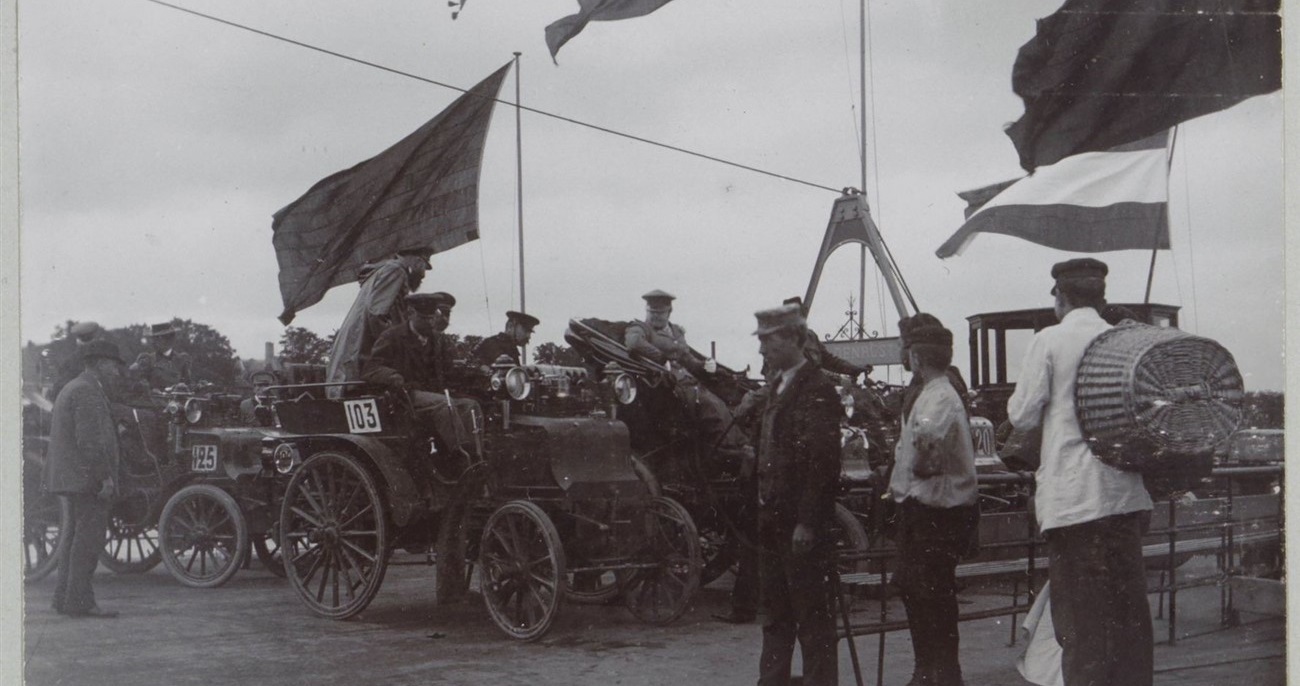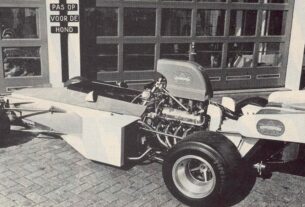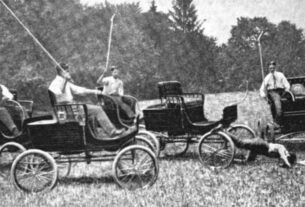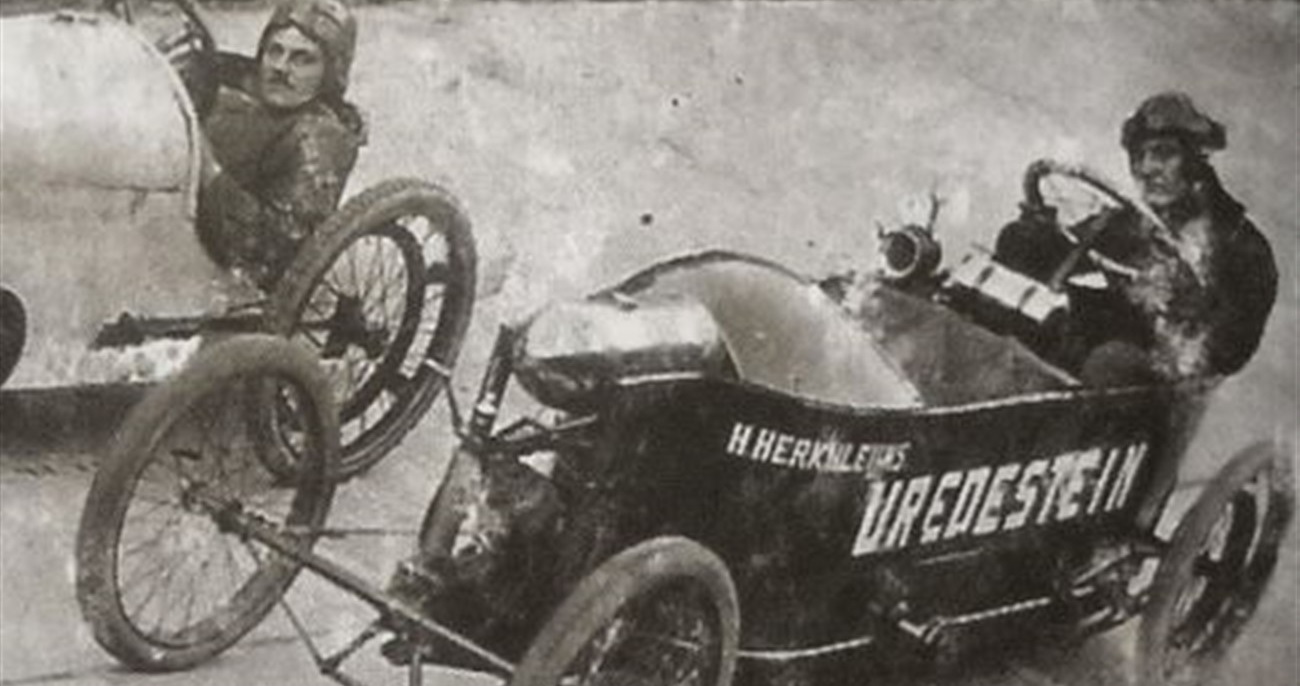Recently i wrote about the first car that appeared on the Dutch roads in 1896. It was the Daimler from notary Backx. However, it seems this was not the first car. The first cars seems to have appeared in 1895 on the road in Tilburg it was from Jos Bogaers-Swagemakers. Wouldn’t surprise me if the first car appeared even earlier. I fit was 1895 or 1896 it is a fact that the first Autosport event happened in July 1898. The famous Paris-Amsterdam-Paris race was organised. The roots were laid down for future events. As in 1899 two more events would be organised one of them the was the first club tour from the just established Nederlandse Automobiel club.
The 3th of July 1898 is a memorable day for the Dutch Autosport, on that day the Nederlandsche Automobiel Club (N.A.C.) was established. This happened after automobile clubs were established in France and England to promote automobilism. When the N.A.C. was established there were no more than 100 cars on the Dutch roads. In the autumn of 1897 the first plans were made for an endurance race Paris-Amsterdam-Paris. Besides the race it was also meant to promote automobilism for the public. How do this better to organise a race through three countries?
Paris-Amsterdam-Paris 7/13 of July 1898
Plenty of articles have been written about this event through the year. It was the first race that would cross borders. The reason The Netherlands were chosen for the race had to do with the fact that the roads were flat, yes already in 1898! This meant that it was relatively easy to drive on and to push the cars even further in reaching to speeds. The French Automobile club decided that the race should be held in the summer. Eventually it was chosen to held the race from 7 until 13 July.
It is not clear how much the exact entrants for the event were, as bikes were allowed as well. Though it was a huge success if you read stories about the race. It is interestingly to read that the organisation had extra trains running in between the distances to collect stranded drivers. It costed them 300 franc to bring them to Amsterdam. As well journalists and interested folk were on the trains. Another interesting aspect is the amount of regulations that unfolded on the Dutch roads. Back in the days the local authorities came up with the rules and safety measures. It was not allowed to go faster than 10 KM/H in villages and busy streets. The streets were even marked with a blue lint to know where to slow down.
The race started in the early morning of the 7th of July with a total length of 1431 kilometres. On the 9th of July the first cars crossed the Dutch border at Maastricht. Onwards the cars would continue racing towards Roermond – Venlo – Nijmegen – Utrecht to eventually finish in Amsterdam. The national highways were mostly used for the race. While local authorities warned their citizens about the danger some incidents did happen on the roads. Usually it happened because people were walking on the roads and didn’t saw the cars, as well animals were scared because of the cars passing by. Overall, the people in The Netherlands who saw the cars passing were happy to see it.
Eventually French Fernand Charron in his Panhard et Levassor was the fastest driver. He finished in less than 33 hours the race with an average speed of 43KM/H. Another interesting fact was the participation of the first woman to race in a car it was Helene de Rotschild. After the cars finished they were on display in the Paleis van Volksvlijt. The cars were posed dirty and smudgy like they finished..
Amsterdam – Aachen 25-06-1899 [Cancelled]
The next event that was to happen was the race from Amsterdam to Aken which would be held the 25th of June 1899. Indeed would be held as the event got cancelled the 12th of June 1899 by the Dutch authorities.
The race was organised by the WestDeutschen Automobil-Club in Aachen. The 6th of June 1899 most of the Dutch papers published an article from the organisation that they were hosting a race between Amsterdam and Aachen where both Dutch and German drivers were allowed to enter. While the race was organised in Germany the start of the race would be just outside the center of Amsterdam where the entrants would start at 7 in the morning. There were two categories for the race. Category I was for motorbikes were the entrant had to pay 20 Deutsch Mark. Catergory II was for the automobiles were the entrant had to pay 30 Deutsch Mark.
This would have been the first race were entrants could actually win trophies and money based on their results. In both categories medals would be given for the top three included an amount of money. First place was 300DM, Second place was 150DM and the third place would be 100DM. Ther was also a maximum time to complete the race, this was set on 14hours as the average speed those days were between 40 and 50 KM/H. While the distance between Amsterdam and Aachen would have been 260KM.
Sadly, the race never happened. There were several reasons probably why the race was cancelled. Besides the Dutch authorities another effect could have been the travel for the German entrants towards Amsterdam. It meant also Visa-Versa for the entrants from Amsterdam who had to return to Amsterdam after the finish. The Dutch authorities were also not happy with the fact that, at that point rules, would be broken like maximum speeds and so on.
The Dutch Automobile Sport Club came with an alternative for the race. Their thoughts were that there would be no positive effect on acceptance for the automobiles holding this race. Their proposal was to held a club tour with a maximum of 20KM/H. From Nijmegen onwards a race could be held up to Aachen.
First Club Tour N.A.C. 16/17 July 1899
The Nederlandse Automobile Club (N.A.C.) was established the 3rd of July 1898 when less then 100 cars were on the Dutch roads. The reason to establish the club was to promote autmobilism in The Netherland to improve the image. Their first event was the Club tour held between the 16th and 17th of July 1899. On the 16th of July 10 á 12 entrants started their engines. Sadly, it is not sure how many drivers appeared for the tour.
The tour went mostly the coast towns on the first day. The start was in Utrecht and eventually went to Amsterdam, Haarlem, Den Haag before they finished in Scheveningen where they would stay for the night. During the first few kilometres the first car already stopped due to a mechanical failure this meant that the race delayed quiet a bit! Eventually they arrived in Scheveningen where the cars were parked on the boulevard where interested could check out the cars. A day later the left Scheveningen to return back they went via Leiden, Woerden to eventually finished at Utrecht.




